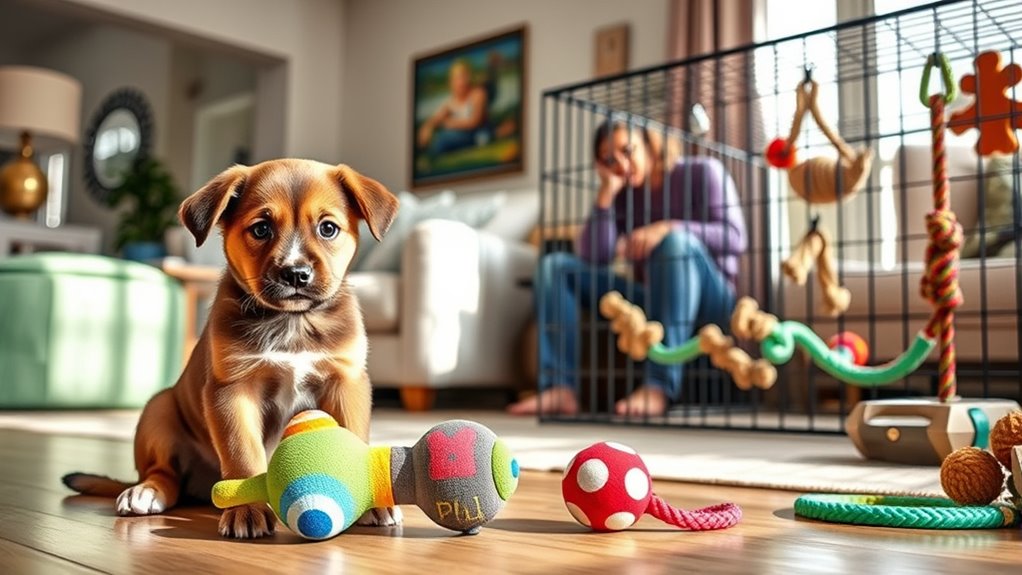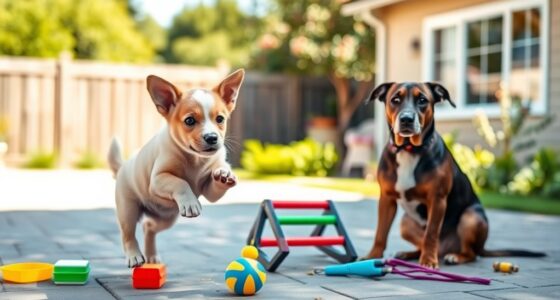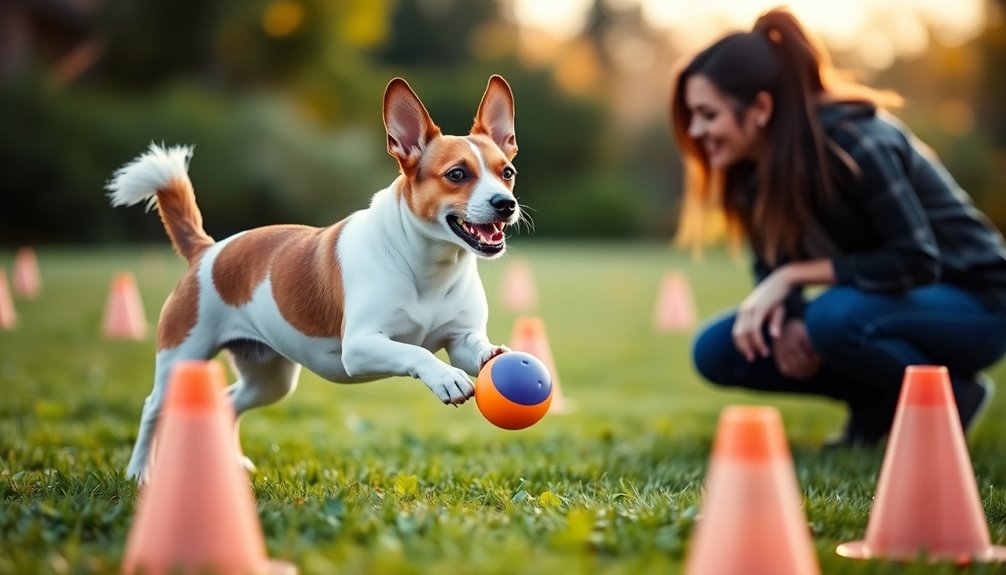To prevent destructive chewing, provide your dog with engaging toys and rotate them regularly to keep their interest high. Supervise closely, especially in new environments, and redirect any chewing to appropriate outlets like toys. Establish a routine with regular playtime and walks to burn energy and reduce boredom. Consistency and patience in training are key. Keep these strategies in mind, and you’ll discover more ways to maintain a happy, well-behaved pet.
Key Takeaways
- Provide engaging, rotating toys to keep your dog mentally stimulated and reduce boredom-driven destructive behaviors.
- Use crate training to create a safe space and prevent damage when unsupervised.
- Closely supervise your dog and redirect destructive chewing with appropriate toys or activities.
- Establish a consistent routine of play, walks, and mental exercises to meet physical and mental needs.
- Practice patience and consistency in training to reinforce positive behaviors and discourage destructive habits.

Chewing and destructive behaviors can be challenging to manage, but proactive strategies can help prevent them before they start. One effective way to do this is by providing your dog with engaging, interactive toys that keep their mind occupied. These toys not only entertain but also help channel your dog’s natural chewing instincts into appropriate outlets. When your dog has access to stimulating toys, they’re less likely to resort to destructive behaviors out of boredom or frustration. Be sure to rotate the toys regularly to maintain your dog’s interest and prevent them from losing enthusiasm for their favorites.
Provide your dog with engaging toys to prevent boredom and destructive behaviors.
In addition to offering interactive toys, crate training plays a vital role in preventing destructive behaviors. A well-trained crate becomes a safe and comfortable space where your dog can relax and rest. When your dog is confined in a crate during times when you’re unable to supervise, you considerably reduce the chances of them engaging in destructive chewing or other unwanted activities. Proper crate training involves making the crate a positive environment through gradual introduction, treats, and praise, so your dog views it as a secure den rather than a punishment. Over time, they’ll learn to settle in the crate without anxiety, which helps prevent destructive behaviors caused by stress or separation anxiety.
Supervision is essential in the early stages of training and behavioral management. You need to watch your dog closely, especially when they’re in new environments or around items they might be tempted to chew. Redirect their attention immediately if they start to chew on something inappropriate, offering a favorite chew toy or an interactive toy instead. Consistent supervision helps reinforce the idea that appropriate toys are the only acceptable objects for chewing. If you catch your dog in the act of destructive behavior, calmly interrupt them and redirect their focus. Over time, this consistent approach teaches your dog which behaviors are acceptable and which are not.
Creating a structured routine can also curb destructive tendencies. Regular playtimes, walks, and mental stimulation sessions reduce pent-up energy and boredom. When your dog’s needs are met through engaging activities and proper supervision, they’re less likely to seek out destructive outlets. Remember, patience and consistency are key. By integrating interactive toys, crate training, and vigilant supervision into your daily routine, you’re setting your dog up for success and fostering a behaviorally healthy, happy pet.
Frequently Asked Questions
How Do I Identify the Specific Triggers for My Pet’s Destructive Behavior?
To identify your pet’s triggers for destructive behavior, observe their behavior patterns closely. Notice when and where they act out, paying attention to environmental cues like specific times, places, or stimuli. Keep a journal to track these instances, noting any changes or patterns. By understanding these cues, you can modify the environment or routine, reducing stressors and preventing future destructive episodes effectively.
What Are the Signs That Enrichment Activities Are Insufficient for My Pet?
Think of your pet as a fire that needs constant fuel. If enrichment activities are insufficient, you’ll notice boredom indicators like lethargy or apathy, and overexcitement signs such as hyperactivity or restlessness. If your pet still chews, digs, or whines excessively despite your efforts, it’s a clear signal they need more engaging stimuli. Keep an eye on these signs, and you’ll know when to add variety to their daily routine.
Can Diet Influence a Pet’s Tendency to Chew Destructively?
Yes, diet impact and nutritional influence can affect your pet’s tendency to chew destructively. If their diet lacks essential nutrients or is overly carbohydrate-heavy, they might seek to satisfy their oral or nutritional needs through destructive chewing. Ensuring a balanced, nutrient-rich diet helps meet their dietary requirements, reducing boredom and frustration. Consult your vet to tailor a diet that supports healthy behavior and minimizes destructive tendencies.
How Do I Modify Supervision Techniques for Different Types of Destructive Behaviors?
Think of supervision like a tailored suit—each piece fits uniquely. For biting, use training methods that emphasize redirection and consistency; for digging, environmental adjustments like barriers or designated areas help. Adjust your supervision based on the behavior’s severity and frequency, staying attentive and proactive. This personalized approach guarantees you address each destructive behavior effectively, transforming supervision into a powerful tool for guiding your pet’s actions.
Are There Breed-Specific Strategies for Preventing Destructive Chewing?
Yes, breed tendencies influence how you approach chewing prevention. For example, retrievers and terriers have strong chewing instincts, so providing durable toys and plenty of exercise helps prevent destructive behavior. You should tailor your strategies to your dog’s breed traits by offering appropriate chew items and mental stimulation. Consistent supervision and positive reinforcement also reinforce good habits, making it easier to manage breed-specific tendencies and prevent destructive chewing.
Conclusion
By providing enriching activities and supervising your pet, you can effectively prevent destructive behaviors. Think of your pet’s energy like a bubbling brook—without enough outlets, it’ll overflow. Keep them engaged with toys, training, and positive reinforcement, so they stay focused and happy. Remember, your guidance is like a lighthouse guiding a ship—keeping them safe and on the right path. With patience and consistency, you’ll create a harmonious environment where both of you thrive.









